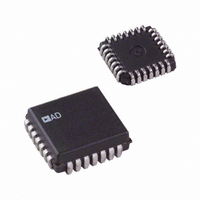AD698APZ Analog Devices Inc, AD698APZ Datasheet

AD698APZ
Specifications of AD698APZ
Available stocks
Related parts for AD698APZ
AD698APZ Summary of contents
Page 1
FEATURES Single Chip Solution, Contains Internal Oscillator and Voltage Reference No Adjustments Required Interfaces to Half-Bridge, 4-Wire LVDT DC Output Proportional to Position kHz Frequency Range Unipolar or Bipolar Output Will Also Decode AC Bridge ...
Page 2
AD698–SPECIFICATIONS Parameter 1 TRANSFER FUNCTION OVERALL ERROR MIN MAX SIGNAL OUTPUT CHARACTERISTICS Output Voltage Range Output Current MIN MAX Short Circuit Current 2 Nonlinearity MIN MAX 3 Gain Error Gain Drift ...
Page 3
NOTES 1 A and B represent the Mean Average Deviation (MAD) of the detected sine waves V multiply V +1 for A > and V OUT COMP+ COMP– OUT 2 Nonlinearity of the AD698 only in units of ...
Page 4
AD698 Typical Characteristics (at +25 C and V 240 200 160 GAIN PSRR 15–18V 120 80 40 GAIN PSRR 12–15V 20 OFFSET PSRR 12–15V 0 OFFSET PSRR 15–18V –20 –60 –40 – TEMPERATURE – C Figure ...
Page 5
THEORY OF OPERATION A block diagram of the AD698 along with an LVDT (linear variable differential transformer) connected to its input is shown in Figure 5 below. The LVDT is an electromechanical trans- ducer—its input is the mechanical displacement of ...
Page 6
AD698 CONNECTING THE AD698 The AD698 can easily be connected for dual or single supply operation as shown in Figures 7, 8 and 13. The following gen- eral design procedures demonstrate how external component values are selected and can be ...
Page 7
Multiply the primary excitation voltage by the VTR to get the expected secondary voltage at mechanical full scale. For example, for an LVDT with a sensitivity of 2.4 mV/V/mil and a full scale of 0.1 inch, the VTR = 0.0024 ...
Page 8
AD698 Note that V should be chosen so that R3 cannot have negative OS value . Figure 12 shows the desired response. V (VOLTS) OUT +10 +5 +0.1d (INCHES) –0.1 Figure 12 V–10 V Full Scale) vs. Displacement ...
Page 9
R2 = 81k – 10kHz EXC –70 0 0.033µF –60 –120 –180 0.1µF –240 R2 = 81k –300 f = 10kHz EXC –360 –420 0 100 1k FREQUENCY – Hz ...
Page 10
AD698 Determining LVDT Sensitivity LVDT sensitivity can be determined by measuring the LVDT secondary voltages as a function of primary drive and core posi- tion, and performing a simple computation. Energize the LVDT at its recommended primary drive level, V ...
Page 11
OUT Solving for 400 and setting R OUT [400 – 19. Choose an oscillator amplitude that is in the range ...
Page 12
AD698 0.005 (0.13) MIN PIN 1 0.200 (5.08) MAX 0.200 (5.08) 0.125 (3.18) 0.023 (0.58) 0.014 (0.36) 0.048 (1.21) 0.042 (1.07) OUTLINE DIMENSIONS Dimensions shown in inches and (mm). 24-Pin Cerdip (Wide) 0.098 (2.49) MAX 24 13 0.610 (15.5) 0.520 ...













